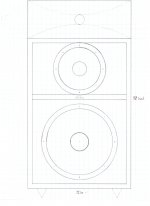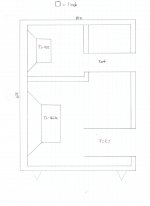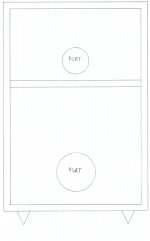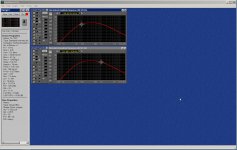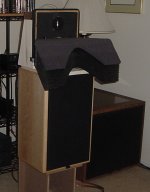Hi Man,
You have certainly selected top notch drivers for your project. As long as you build solid boxes and have decent electronics they'll sound great.
Here are a few basic comments.
- Mount the 1102's in small (~1cu-ft) internal sealed enclosures. Stuff those enclosures with dacron batting or some sort of acoustic damping material. Do not port this enclosure.
- Concentrate your design efforts on the boxes for the 1601's. These drivers are not made to move a lot of air below about 30Hz. My 1601's are in 4.5cu-ft ported enclosures. The ports are 4" diameter and 4.25" long. This provides a cutoff of about 38Hz with a shallow slope down to about 20Hz. I use an electronic boost to extend the cutoff down to about 28Hz with a pretty steep slope below that.
- Stay away from solid wood panels. They will resonate and give you peaks and dips in your response. Think about void free plywood or MDF. There are hundreds of threads on this subject so you need to do more study but these materials are a good start, they are readily available, relatively easy to work with, and will provide good results.
- Bracing, bracing, bracing, bracing and bracing.
- I am assuming that you will be tri-amping so be sure to put a high pass filter between your high range amp and the 4001's jsut in case your amp decides to output something in the lower frequencies. The beryllium diaphragms will not take too kindly to much low frequency drive. You will not want to replace these diaphragms too often at $900+ each (that's if you can find them).
- I don't know too much about the Accuphase crossover but it looks to have plenty of adjustability for experimentation.
- Take your time.
Good luck, I'm sure you will end up with great sounding speaker.
You have certainly selected top notch drivers for your project. As long as you build solid boxes and have decent electronics they'll sound great.
Here are a few basic comments.
- Mount the 1102's in small (~1cu-ft) internal sealed enclosures. Stuff those enclosures with dacron batting or some sort of acoustic damping material. Do not port this enclosure.
- Concentrate your design efforts on the boxes for the 1601's. These drivers are not made to move a lot of air below about 30Hz. My 1601's are in 4.5cu-ft ported enclosures. The ports are 4" diameter and 4.25" long. This provides a cutoff of about 38Hz with a shallow slope down to about 20Hz. I use an electronic boost to extend the cutoff down to about 28Hz with a pretty steep slope below that.
- Stay away from solid wood panels. They will resonate and give you peaks and dips in your response. Think about void free plywood or MDF. There are hundreds of threads on this subject so you need to do more study but these materials are a good start, they are readily available, relatively easy to work with, and will provide good results.
- Bracing, bracing, bracing, bracing and bracing.
- I am assuming that you will be tri-amping so be sure to put a high pass filter between your high range amp and the 4001's jsut in case your amp decides to output something in the lower frequencies. The beryllium diaphragms will not take too kindly to much low frequency drive. You will not want to replace these diaphragms too often at $900+ each (that's if you can find them).
- I don't know too much about the Accuphase crossover but it looks to have plenty of adjustability for experimentation.
- Take your time.
Good luck, I'm sure you will end up with great sounding speaker.
Last edited:
Thank you very much Rodd,
Could you tell me more on why I should not port the 1102 enclosure?
BassBox Pro definitely recommend ported box for the 1102. Probably because BassBox assumes that the 1102 will be used as woofer. I designed a 1 cu. ft.closed box in BassBox for the 1102 with "heavy" stuffing. The response graph shows that the ported box is better than the closed box in the mid-low range. Don't you use BassBox as well?
I will take your advice on the wood material. Please be more specific on what material. What do you think of birch plywood? Also, what do you think is the best thickness?
It will be a 4-way system. I will definitely look into a high pass filter. I am thinking of running the 4001 with 300B SET.
Everyone is welcome to chime in. Your comments will be greatly appreciated.
Man
Could you tell me more on why I should not port the 1102 enclosure?
BassBox Pro definitely recommend ported box for the 1102. Probably because BassBox assumes that the 1102 will be used as woofer. I designed a 1 cu. ft.closed box in BassBox for the 1102 with "heavy" stuffing. The response graph shows that the ported box is better than the closed box in the mid-low range. Don't you use BassBox as well?
I will take your advice on the wood material. Please be more specific on what material. What do you think of birch plywood? Also, what do you think is the best thickness?
It will be a 4-way system. I will definitely look into a high pass filter. I am thinking of running the 4001 with 300B SET.
Everyone is welcome to chime in. Your comments will be greatly appreciated.
Man
Thank you very much Rodd,
Could you tell me more on why I should not port the 1102 enclosure?
BassBox Pro definitely recommend ported box for the 1102. Probably because BassBox assumes that the 1102 will be used as woofer. I designed a 1 cu. ft.closed box in BassBox for the 1102 with "heavy" stuffing. The response graph shows that the ported box is better than the closed box in the mid-low range. Don't you use BassBox as well?
There’s no reason to use a ported box for the mid-bass. The ported box will only serve to complicate the design and add distortion to the output. The 1102 will work fine in a closed box over the range in which you want to use it.
I would, however, consider extending the upper range of the 1102 out to 1kHz or possible a bit higher. There are a number of reasons for this but the main reason would be to unload the 4001 from having to reproduce the lower frequencies to further protect the diaphragms and help to lower distortion.
I try to keep the BW of any single driver to 3 octaves or less (horns can handle more than direct radiators). This isn’t always possible but if not, there should be a good reason for the BW extension. I also like to set a drivers cut-off at least an octave inside the manufacturers specification for BW range. Doing this will significantly lower IM distortion and help to keep the driver operating in a “comfortable” range.
I will take your advice on the wood material. Please be more specific on what material. What do you think of birch plywood? Also, what do you think is the best thickness?
Birch plywood is fine. It will depend on your tastes for finishes. What is important is to use void free plywood. Marine supply houses are a good source for void free plywood. I would, however urge you to search for as many threads on this subject as possible. There are many detailed discussions on this subject by many here with more knowledge and experience than me, particularly on this subject.
FWIW, my 1601 subs are made from 1-1/4” MDF with ¼” plywood laminate and wood grain (teak) formica covering. The baffles are made from 1-1/2 MDF with ¼” plywood laminate to flush mount the drivers.
My mid-basses are made from old JBL L77 Lancer boxes on which I laminated the sides with ¼” plywood and added ½” MDF to the rear. The baffles were also laminated with ½ MDF plus ¼” plywood to flush mount the 2 – JBL LE10A’s per box. I added ¾” strips routed quarter-round to all of the corners for finish.
Attachments
Thank you Rodd.
I will go with a closed box for the 1102. This would be much easier.
I will cross the between the 1102 and TD-4001 at 1000Hz. The Accuphase F25 has 1000Hz and 1200Hz cross point. I think 1200Hz might be too high.
"I try to keep the BW of any single driver to 3 octaves or less (horns can handle more than direct radiators). This isn’t always possible but if not, there should be a good reason for the BW extension. I also like to set a drivers cut-off at least an octave inside the manufacturers specification for BW range. Doing this will significantly lower IM distortion and help to keep the driver operating in a “comfortable” range."
I have no idea what you are talking about here. What does BW stands for? I wasn't kidding when I said I am new
Also, what do you recommend crossing between the TL-1601a and TL-1102?
The Accuphase F-25 active crossover have the following frequencies:
50
70
100
130
180
250
290
300
350
500
650
800
1000
1200
1800
2500
3500
5000
7000
8000
10000
12500
I will go with a closed box for the 1102. This would be much easier.
I will cross the between the 1102 and TD-4001 at 1000Hz. The Accuphase F25 has 1000Hz and 1200Hz cross point. I think 1200Hz might be too high.
"I try to keep the BW of any single driver to 3 octaves or less (horns can handle more than direct radiators). This isn’t always possible but if not, there should be a good reason for the BW extension. I also like to set a drivers cut-off at least an octave inside the manufacturers specification for BW range. Doing this will significantly lower IM distortion and help to keep the driver operating in a “comfortable” range."
I have no idea what you are talking about here. What does BW stands for? I wasn't kidding when I said I am new
Also, what do you recommend crossing between the TL-1601a and TL-1102?
The Accuphase F-25 active crossover have the following frequencies:
50
70
100
130
180
250
290
300
350
500
650
800
1000
1200
1800
2500
3500
5000
7000
8000
10000
12500
Hi Man,
BW = Band Width - The listed BW for the 1102 is 30Hz - 3kHz.
With the crossover you have you don't have to worry too much about where you cross from one driver to the next. As a start you might try 130Hz at first but it will work anywhere from 70Hz to 500Hz. The crossover to the 4001's are pretty flexible as well and would probably work fine anywhere between 500Hz and 2500Hz. Of course the sound will change as you change the xover points but that's the flexibility you will have to play with once you have your speaker built and setup.
There are a thousand other details that will impact on the final sound of your speakers. Some details will have a bigger than others. As I said before, do some searching and reading and take your time. Everthing I've said here has been covered multiple times on this forum alone, not to mention the other forums on the web.
the other forums on the web.
BW = Band Width - The listed BW for the 1102 is 30Hz - 3kHz.
With the crossover you have you don't have to worry too much about where you cross from one driver to the next. As a start you might try 130Hz at first but it will work anywhere from 70Hz to 500Hz. The crossover to the 4001's are pretty flexible as well and would probably work fine anywhere between 500Hz and 2500Hz. Of course the sound will change as you change the xover points but that's the flexibility you will have to play with once you have your speaker built and setup.
There are a thousand other details that will impact on the final sound of your speakers. Some details will have a bigger than others. As I said before, do some searching and reading and take your time. Everthing I've said here has been covered multiple times on this forum alone, not to mention
 the other forums on the web.
the other forums on the web.I assume you have already built this. I just ran across this thread while doing a search. If you have finished this and everything is to your liking then ignore my late 2 cents worth.
1st thing is your tweet is fast as a bullet. I don't know about the woof but I bet it ain't. Your drivers are probably not time aligned if the drawings are accurate as to where the VCs are located. The VCs should be one right over the other for timing.
If things are still a little muddy after that you might think of loosing a bit of space inside the box if you don't want to build another and put a second driver behind the first in an isobaric set up to push up the speed of the bass. The sound of the pusher is probably not that important, just get something the same size (cone) and that has the same or very close to the same excursion and it will speed the woof up fast enough to keep up with a compression driver/horn tweeter. The rest is just box tuning, but tuning will not overcome differences in distance to the ear and speed of drivers.
I haven't signed on here in quite a while but it is a great group of DIYers. I bet your system is sounding great.
Thatch
1st thing is your tweet is fast as a bullet. I don't know about the woof but I bet it ain't. Your drivers are probably not time aligned if the drawings are accurate as to where the VCs are located. The VCs should be one right over the other for timing.
If things are still a little muddy after that you might think of loosing a bit of space inside the box if you don't want to build another and put a second driver behind the first in an isobaric set up to push up the speed of the bass. The sound of the pusher is probably not that important, just get something the same size (cone) and that has the same or very close to the same excursion and it will speed the woof up fast enough to keep up with a compression driver/horn tweeter. The rest is just box tuning, but tuning will not overcome differences in distance to the ear and speed of drivers.
I haven't signed on here in quite a while but it is a great group of DIYers. I bet your system is sounding great.
Thatch
- Status
- This old topic is closed. If you want to reopen this topic, contact a moderator using the "Report Post" button.
- Home
- Loudspeakers
- Multi-Way
- Need Help w/ Bass Cabinet for TAD TL-1102 & TL-1601a. Use w/ TD-4001 & Yamamoto Horn
